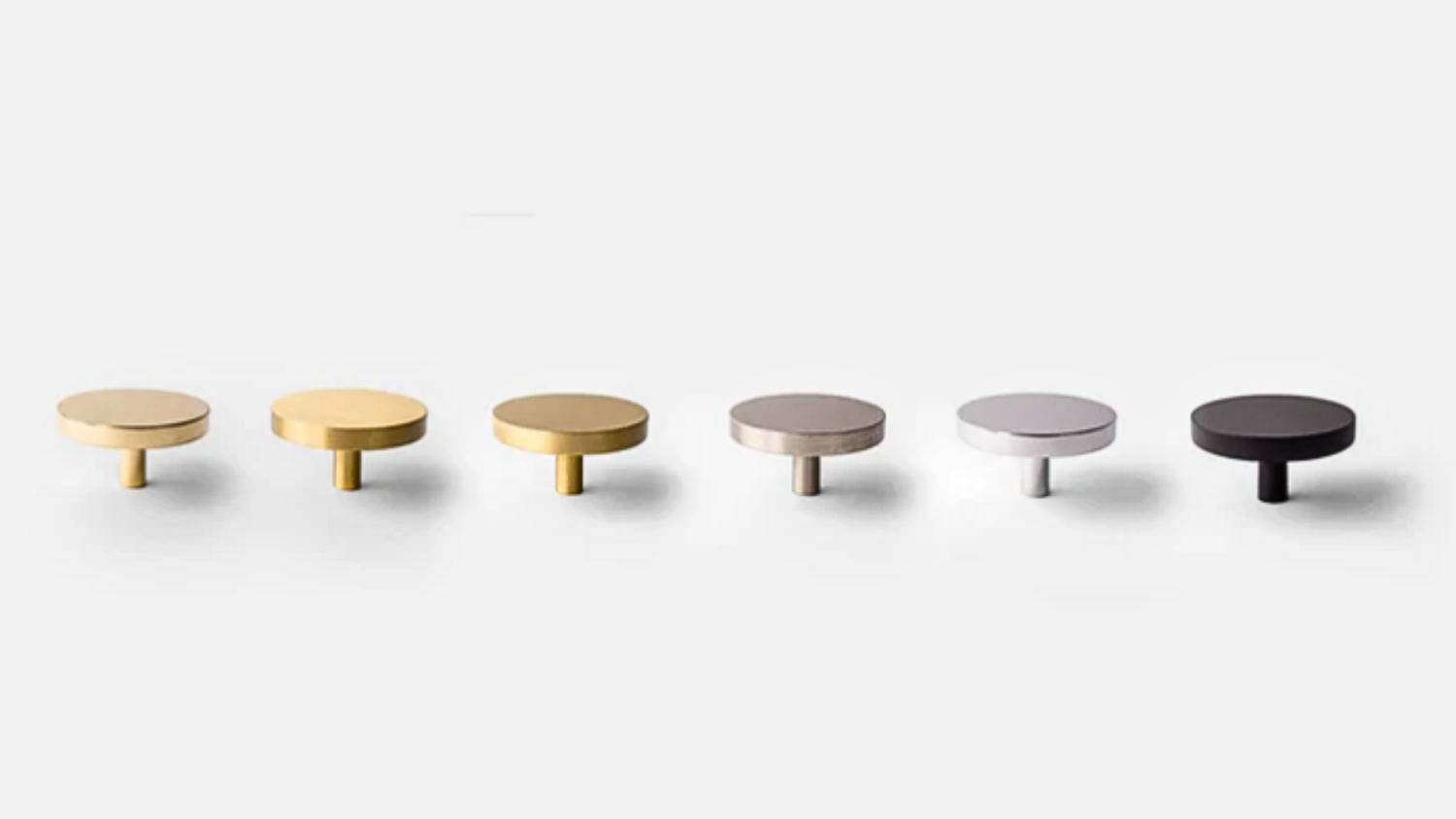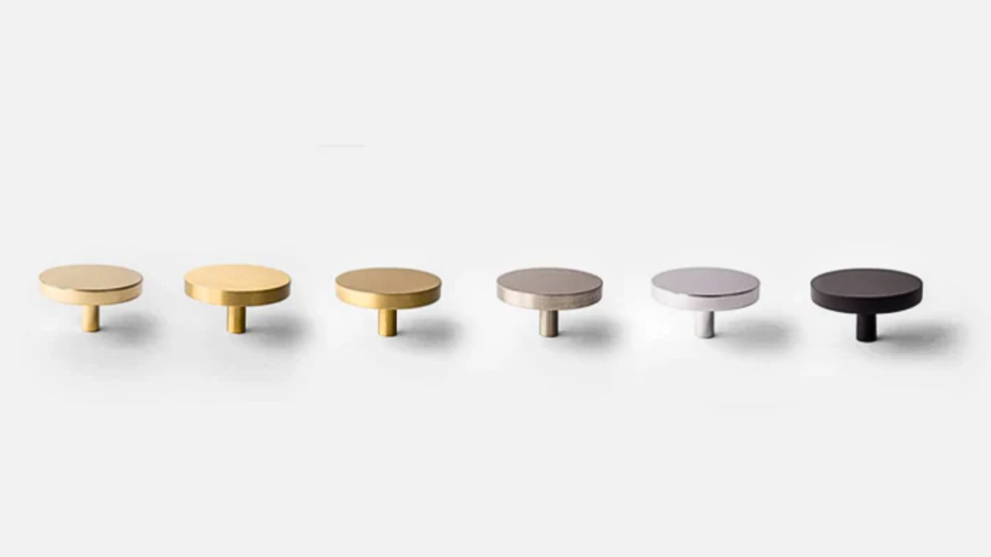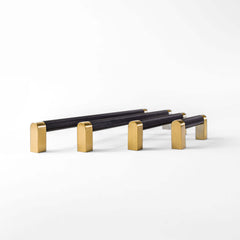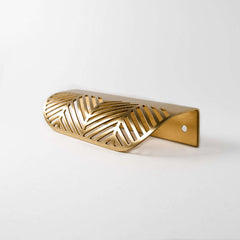Key Takeaways:
- Warmth Versus Radiance: Brushed brass emanates warmth and artisanal beauty, while brushed gold offers luminous sophistication and a modern glow. Each finish contributes a distinct emotional tone, influencing how your space feels at first glance and over time.
- Differences In Tone, Texture, & Durability: Brushed brass and brushed gold finishes differ in color tone, surface texture, and resilience. Choosing between them allows you to align your selection with your space’s ambiance, touch preferences, and functional requirements.
- Considerations Beyond Aesthetics: Selecting the right finish involves evaluating how it interacts with natural and artificial light, its maintenance needs, and its sustainability profile. These subtle factors help shape a space that’s not just stylish—but intentionally built.
At Inspire Hardware, every piece is guided by architecture, proportion, and material truth. Our hardware is engineered for precision fit, timeless finish integrity, and a visual language that speaks quietly but confidently. We craft hardware with the kind of consideration that earns its place in both high-design spaces and daily life.
If you’ve ever stood in a showroom holding two nearly identical pulls, one labeled brushed brass, the other brushed gold, you’re not alone. These finishes can look strikingly similar, yet choosing the right one affects the mood of a space and how other materials interact around it. Understanding the nuances of brushed brass vs brushed gold helps eliminate guesswork and leads to selections that feel more aligned, layered, and intentional.
In this blog, we will explore the visual and tactile differences between brushed brass and brushed gold, how each finish interacts with light and surrounding materials, and what to consider when choosing one for your design vision.
Texture Reveals: What The Brushing Process Adds To Each Finish
The brushing process, a craft honed through generations, leaves more than a visual impression, it transforms raw brass and gold into tactile experiences, each with their own voice.
Brushed Brass: A Finish With Heritage
Brushed brass comes alive beneath careful, consistent strokes. The brushing softens the metal's natural luster, muting bright reflections and creating a play of light that feels organic, almost lived-in. Subtle linear grain lines become a signature, tracing the path of each brush and lending a sense of movement across the hardware.
Brushed Gold: Quiet Glamour And Soft Radiance
Brushed gold, on the other hand, carries an air of quiet glamour. The brushing here results in a satiny surface that scatters light in gentle glimmers, gently diffusing gold’s inherent brilliance rather than muting it entirely. Those delicate, parallel brush marks dance with surrounding colors and textures, adding depth and intrigue without overpowering a room’s palette.
For those considering mixed-metal hardware ideas, brushed textures offer a subtle way to connect finishes without competing for attention. Pairing brushed brass with matte black or brushed gold with warm nickel can create layered elegance, especially in kitchens or baths where lighting plays across different surfaces.
Every Day Durability And Scratch Resistance Compared
Practicality is a necessity when selecting hardware for spaces that see daily use, such as a family kitchen or a striking entry hallway.
Brushed Brass: Forgiving Character That Ages Gracefully
Brushed brass, owing to its solid-alloy composition, stands out for its inherent sturdiness. Every day contact, grips, grazes, and the occasional clang of a wedding band tend to blend into the lived-in patina, fostering character without drawing unwanted attention to wear. If you're still comparing brass finishes, brushed brass is often preferred, whereas longevity and natural charm are prioritized.
Brushed Gold: Subtle Sophistication With A Need For Care
Brushed gold finishes offer a sumptuous, gently gleaming appearance that feels at home in settings demanding finesse. While modern finishing processes impart a degree of scratch resistance, maintaining their flawless look can require more intention. Fingerprints, micro-abrasions, and surface marks may register more strongly on brushed gold, calling for gentle care.
Built To Last, But Shaped By Your Lifestyle
In the hands of craftspeople, both finishes are designed to endure. Still, your lifestyle, stewardship, and the soul of your space will influence which material’s character deepens to tell your story best. Understanding brass finishes explained in terms of both material composition and surface treatment can help you make a choice that balances appearance, function, and long-term performance.
Maintenance Routines To Keep Each Finish Luminous
Your brushed brass and brushed gold hardware are tactile statements, worthy of care that honors their refined character. The best maintenance routines preserve their true radiance and uniquely textured glow.
- Use Soft Cloths For Regular Cleaning: Wipe brushed brass and brushed gold hardware weekly using a dry microfiber cloth. This removes surface dust and prevents buildup that could wear down the finish over time. A slightly damp cloth can be used for fingerprints.
- Avoid Harsh Cleaners & Abrasives: Avoid ammonia, vinegar, and abrasive sponges. These substances can damage the brushed texture and dull the metal. For routine cleaning, stick to a solution of warm water and mild, pH-neutral soap.
- Follow The Grain When Buffing: Always clean toward the metal’s brush lines. This maintains the texture’s clarity and helps avoid creating swirl marks or irregular polishing patterns, especially on satin-finished surfaces like gold cabinet hardware.
- Dry Thoroughly To Prevent Water Spots: After damp cleaning, dry the hardware immediately with a soft towel. Standing moisture can leave mineral traces, especially on gold-toned finishes, where spotting is more noticeable under certain lighting conditions.
- Treat Fingerprints Gently: Smudges and oils are inevitable and frequently used. Remove them with a soft cloth dampened with warm water and a drop of soap, then dry thoroughly. This prevents buildup that can dim reflective finishes.
- Limit Use Of Polish On Unsealed Finishes: If your brass is unlacquered, you may use a non-abrasive brass polish sparingly—but always test in a hidden area. Frequent polishing can strip intentional patina or prematurely age the surface.
- Preserve The Finish Over Time: Brushed brass naturally develops a patina with age, which many consider desirable. Routine, gentle cleaning slows this evolution while keeping the finish visually cohesive. Brushed gold, by contrast, benefits from routine buffing to retain its controlled luster.
- Keep Templates & Cleaning Separate: If you're using placement templates during installation or maintenance, always clean the surface before applying them. Dust trapped under template guides can scratch the finish, particularly on refined metals like brushed brass and gold.
Choosing The Right Finish For Kitchens And Baths With High Humidity
Humidity is a constant player, shaping atmosphere and material longevity. When selecting between brushed brass and brushed gold finishes for your cabinet hardware, understanding how these finishes respond to moisture-rich environments becomes crucial.
The Living Character Of Brushed Brass
Brushed brass, made from solid brass, develops an evolving patina, particularly in high-humidity spaces. The finish deepens in tone, revealing a living surface that subtly changes with use and environment. This organic transformation is often prized in bespoke interiors, lending an aged, storied feel. Lacquered options are available for more controlled aging, but even those will shift gently over time.
The Consistency And Protection Of Brushed Gold
Brushed gold finishes, usually created with solid brass or zinc alloy cores, are enhanced with titanium or PVD coatings. These processes boost resistance to tarnish, watermarks, and fingerprints, making brushed gold ideal for damp environments. For those who want a finish that holds its hue and texture with minimal upkeep, brushed gold offers elegance with resilience.
Choosing Based On Your Design Intent
Whether you're designing around rustic warmth or refined clarity, how you want the hardware to age matters. Brushed brass offers depth and character that evolve, while brushed gold provides a steady, luminous tone. The finish you choose should reflect your visual preferences and how you interact with the space daily.
Bringing It Into The Kitchen
Spaces like the kitchen benefit immensely from finishes that combine beauty with performance. If you aim for a sophisticated but approachable look, our gold kitchen cabinet handles offer a radiant tone that complements classic and contemporary cabinetry. Their protective finish helps them retain beauty despite heavy use and fluctuating moisture.
Your Quick Checklist For Selecting The Perfect Brushed Finish
Choosing between brushed brass and brushed gold? Use this quick checklist to align tone, texture, and care requirements with your space’s lighting, usage, and design style for a confident decision.
- Start With Your Palette: Evaluate the hues dominating your cabinetry, wall color, and nearby fixtures. Brushed brass brings rich warmth with a telltale golden depth, while brushed gold offers lighter, contemporary elegance with a hint of subtle glamour.
- Assess Texture & Sheen: Observe natural light at different times of day. Brushed brass has a softer, matte surface that speaks to heritage and timelessness. Brushed gold reflects with a brighter, modern clarity; its lighter finish often pairs seamlessly with cool-toned environments.
- Consider The Design Narrative: Draw inspiration from your overarching vision. Do you gravitate toward storied, European-inspired charm or crave sculptural, cutting-edge silhouettes? Each finish conveys its own story, from old-world refinement to radiant minimalism.
- Factor In Wear & Patina: Think about how you want your hardware to evolve. Brushed brass ages gracefully, developing a unique patina that marks cabinets with character. Brushed gold tends to resist tarnishing, maintaining its crisp luster with less visible change.
- Integrate With Existing Metals: Survey your space for nearby metal accents, appliance pulls, lighting, and even door hinges. Find resonance by matching undertones or cultivate deliberate contrast for a curated, designer-like effect.
- Touch & Feel: Whenever possible, handle samples. The tactile distinction, substantial weight, smoothness of the brushing, and the way the finish feels under your fingertips offer a sensory clarity that images can’t capture.
- Don’t Forget Functional Pairings: The finish should align with form whether you’re working with tall pantry doors or compact drawers. This is especially true for brass cabinet knobs, where the combination of finish and silhouette defines how the piece feels in use.
Final Thoughts
As you weigh brushed gold vs brushed brass, you curate an atmosphere, telling a story with every touchpoint in your space. Brushed brass exudes warmth, substance, and the enduring beauty of artisanal metalwork, while brushed gold leans into luminous sophistication, casting a gentle, modern glow. Each finish brings its energy and nuance, shaping how cabinetry, furniture, and architectural details command attention and invite interaction.
At Inspire Hardware, you can define your vision with exclusive, handcrafted designs and truly distinctive finishes. Our collections are born from a dedication to the craft and a deep respect for how hardware transforms the everyday, making it exceptional.
We invite you to linger over every detail and select hardware that complements your surroundings and enhances your project from concept to heirloom. Let’s collaborate to ensure that every finish reflects your taste.
Read more:
- Polished Nickel Vs Chrome: What's The Difference And Which To Choose?
- Modern vs. Vintage Hardware: How to Choose for Your Unique Space
- Matte Finishes vs. Polished: How to Pick the Right Look and Feel for Your Home
Frequently Asked Questions About Brushed Brass vs Brushed Gold
What is brushed brass?
Brushed brass is a finish crafted by gently texturing solid brass, resulting in a soft, satin-like sheen that plays quietly with light. This artisanal process enhances the brass’s natural golden hue while muting its shine, creating a tactile, elegant, and sophisticated surface. In the hands of a skilled maker, brushed brass expresses warmth and a subtle, timeless richness.
Is brushed brass more yellow compared to brushed gold?
Brushed brass typically displays a more yellow undertone compared to brushed gold. Its color echoes classic brass instruments and vintage heirlooms, radiating warmth and nostalgia. Brushed gold, in contrast, is often formulated with warmer, deeper golden or champagne notes, offering a softer and sometimes more modern appearance.
How do the colors of brushed brass and brushed gold differ?
Brushed brass embodies a lively, golden-yellow tone with hints of antiquity and charm, making it ideal for interiors that echo tradition or vintage allure. While visually similar at first glance, brushed gold leans towards a richer, more golden or subtly rose-toned palette. The result is a finish suited for spaces where you wish to evoke opulence, contemporary luxury, or a softer, more refined gold motif.
Which finish is warmer in tone, brushed brass or brushed gold?
Brushed gold generally presents a warmer, more sumptuous tone than brushed brass. While both finishes evoke warmth and sophistication, brushed gold’s rich undertones deliver depth and coziness, perfectly complementing luxurious textures and palettes.
What is brushed gold?
Brushed gold is a specialty finish achieved by layering a sophisticated golden tone over solid brass, then delicately brushing the surface to reveal a matte, velvety luster. The result is a glowing, refined finish that stands apart for its warmth and elegance, making it a favorite for those seeking a touch of modern glamour.
Are the manufacturing processes for brushed brass and brushed gold different?
The foundational technique, brushing the surface for a fine-textured matte effect, remains consistent. However, brushed brass involves working directly with solid brass, revealing its authentic color beneath the brush. Brushed gold usually adds a custom gold-toned plating or coating before brushing, infusing the metal with a distinct hue without masking the underlying craftsmanship.







